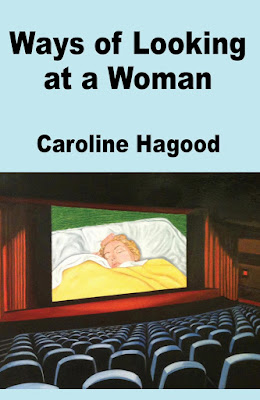I took a
couple of days off after reading
Ways
of Looking at a Woman
because I wanted the roiling, frolicking notions implanted by this
droll, ingenious look at writing, academics,
mothering, movies, womanhood, self-hood,
and
probably a few things I’m not remembering at the moment...I wanted
them, the notions, to sort themselves
out
unmolested so
I could see if the buoyant, sparkling mood this brief dance of poetic
prose put me in would last beyond violent interruption by the book
about an insane US president I had to read, and, if so, if it survived, to see
if a closer look might reveal just how
Caroline Hagood worked her literary
witchcraft.
My
Ways-induced
euphoria’s
intensity,
as I’d suspected, bullied me to cancel
the experiment for fear intentional
exposure to something notably
obnoxious
might
unfairly dilute
this sweetly
sensual spell.
It
became a struggle of willpower, which I won, possibly with the
serendipitous help from a silly ditty making the rounds on social
media. The lyrics parodied a popular tune for children:
If
you’re happy and you know it, overthink
If
you’re happy and you know it, overthink
If
you’re happy and you know it,
Give
your brain a chance to blow it
If
you’re happy and you know it, overthink
How
could it help, you wonder, when the
ditty was in-my-face
indicting
me,
a chronic worrier that happiness is a sham, simply
a
sly
subconscious
mechanism
for avoiding the ubiquitous signs of decay and
injustice and
suffering and
death and hideous executive
hairstyles. Well, it didn’t help. Not me. Not directly. Indirectly
it
did,
because as I knew its taunting, rhymy little message with its insipid
tune
insinuating itself into my brain as a damnable ear worm should have
deflated
the euphoria Hagood’s magic had
given
me, but
it
didn’t!
And
Hagood clearly was more vulnerable to overthinking than I am. In fact
overthinking is the wings
of
Ways:
extended angsty juggling of interplaying expectations, obstacles,
disappointments, writing failures,
academics,
mothering, movies, womanhood, self-hood,
and
those
other probable things I’m still trying to remember. Hagood
lays out the challenge with her first two paragraphs:
It
electrocutes me in the best possible way to watch the thoughts
marching from afar like a terrifying army.
What’s
this sick compulsion to shatter the celluloid that encases me, write
my way out with a lyric essay, pervade, project light through light,
wrap my head around what I am: a movie in the shape of a
woman, seeing and being seen, writer-mother, a mixed genre, a person
with another person growing inside her?
I
had to look twice to find the counterpoise among the negatives, the
“terrifying” and “sick compulsion” and “celluloid”
encasing her, but there it was: the incipient spirit that
graces not only the opening but the entire piece: a sense of
irrepressible ebullience, of joie
de vivre, of
wry, self-effacing
humor
that underlies virtually every thought, hell--every word
in Ways
of Looking at a Woman.
“It
electrocutes me in the best possible way,” she
says of the “army” of thoughts marching toward her to conquer her
happiness. She’s ready for them. Her hardy, drolly welcoming nature
beckons them to bring it on. And they do, and one helluva fight
ensues. And me, watching from the catbird seat, I’m gasping with
admiration, interspersed with honest laughter, taking notes like
crazy, all the way.
I
might have missed the whole show, tho, had I been a creature of
academia and discovered at the very beginning this woman’s doctoral
dissertation was quite the inept, fumbling,
disorganized, hootenanny ramble of scrambled notions daring to go
public before enduring the de
rigueur
gauntlet of peer and advisory reviews. Sacre
bleu!,
I might have ejaculated flinching at the “research proposal”
section's failure to conform strictly
to
the ivoried
rigors
of academic structure. These
reviewers would have withheld their horrified
gasps
reading the first two paragraphs, quoted
above, granting a brow-cocked pass on a presumed
cleverly
outré
lead-in to the
coherent,
no-nonsense
hypothesis with its
sufficient
data/citations and perhaps a preliminary pie or bar graph or two
before launching into the
deadly serious “abstract,”
with more of the same rendered more cautiously
and, most importantly of course, delivered in a timidly passive
voice. Here
is where I, were I the hypothetical bowel-constricted peruser, would have
blown into a bewildering profusion of dancing question marks, each
presenting a smirking little face forcing me upon my gown-muffled
oath, were I an 18th
century diplomaed pirate, to utter the dreaded ARRRRRRRRRRR
and hurl the blasphemous excuse for a dissertation as far and wide as
its unbound, coffee-stained leaves would carry it. Here precisely is
where it would have happened, when I read these very words:
“And
what will happen if I can’t? Will my skin curl, crack, and harden
till I’m mummified, bundled beetle-like in my own ambition? If only
someone had told me early on, ‘You will never get the orange peel
off in one clean spiral, but more haunting shapes will come out of it
in the end.’”
It
was here, still trying to imagine what new license had
been unleashed in the ivied walls of higher learning, that I glanced
at the table of contents and then scrolled quickly through the essay
to learn to my raucous amusement that Caroline Hagood was making fun
of traditional strictures, that her essay, which, while properly
peppered with sources and
hedged
arguments complete with big words, was really just a cap-and-gown
garbed poem about the inner and outer life of a brilliant, original,
contradicted, adventurous, questing poetic mind that paid no heed
whatever to its faux-architectural disguise. She leaps and
somersaults and backflips and handwalks her words down page after
page, ignoring such divisions as “methodology” and
“acknowledgments,” with its “introduction” in the middle, and its real acknowledgments in the “appendices” at the very
end.
Involuntary
giggles continue to diesel in my throat every time I recall Ways
to Look at a Woman’s send-up
of ivory-towered pomposity. And this, while knowing she’s busy
working on an actual doctoral dissertation, to which she refers with
gentle, respectful humor time and again.
The
only catiness I found in Ways
of Looking at a Woman
was directed at Norman Mailer, who, altho profoundly influencing my
outlook coming of age, I see now most definitely deserves the hisss
and scratch of Hagood’s claws in her book. I shan’t include any
quotes, as I’d hate to instigate a futile brouhaha here in the
relatively chaste cloister of my blog.
 |
| Male Ego Personified |
I
said earlier I took a lot of notes. That was understatement. I copied
twenty-six pages of quotes from the book to my
offline review document. I cannot share many more with you, as the review then would risk straying into legal jeopardy as plagiarism.
Yet, I cannot pass up, for example, something like this:
“Mostly I didn’t write a memoir because nobody wants to read
something called The Subtle Art of Writing While Covertly Watching a
Zombie Movie, Playing Make-believe with a Tantrumming Kid, and Eating
Taquitos.”
Or
this:
“I
started wanting to use ‘I’
in the dissertation where it didn’t belong. On every page, Caroline
kept popping up—making lewd gestures behind a footnote, mooning me
from behind a piece of particularly dry text.”
I’m
gonna pound away at my computer to create the perfectly positioned
thought UFO to abduct my reader. – Caroline
Hagood, Ways of Looking at a Woman
Dear
Reader,
she
tells me, and only
me, I’ve
taken the liberty of imagining you as my soul mate, lover, best
friend, that person I’ve been looking for my whole life who will
make me feel less alone, understand my ravings, my UFO to nowhere.
The point is I see you. Consider yourself seen.” I
suppose this should be at the top in one of those full-disclosure
boxes disqualifying me as an objective reviewer. You can fool some of
the people...
 |
| Meryl Streep? |
Anyone
so enticed by this thoroughly subjective rave they might wish to read
a real review should click here, on Pank
Magazine, for Dr.
Patricia Grisafi’s knowledgeable, academically sound look at Ways
of Looking at a Woman.

No comments:
Post a Comment